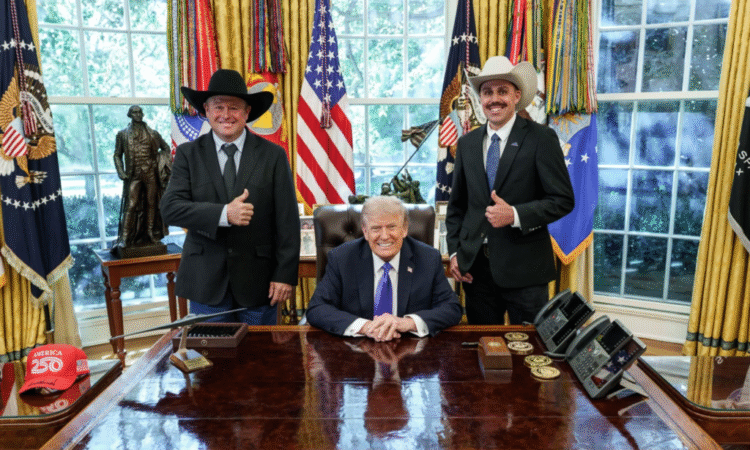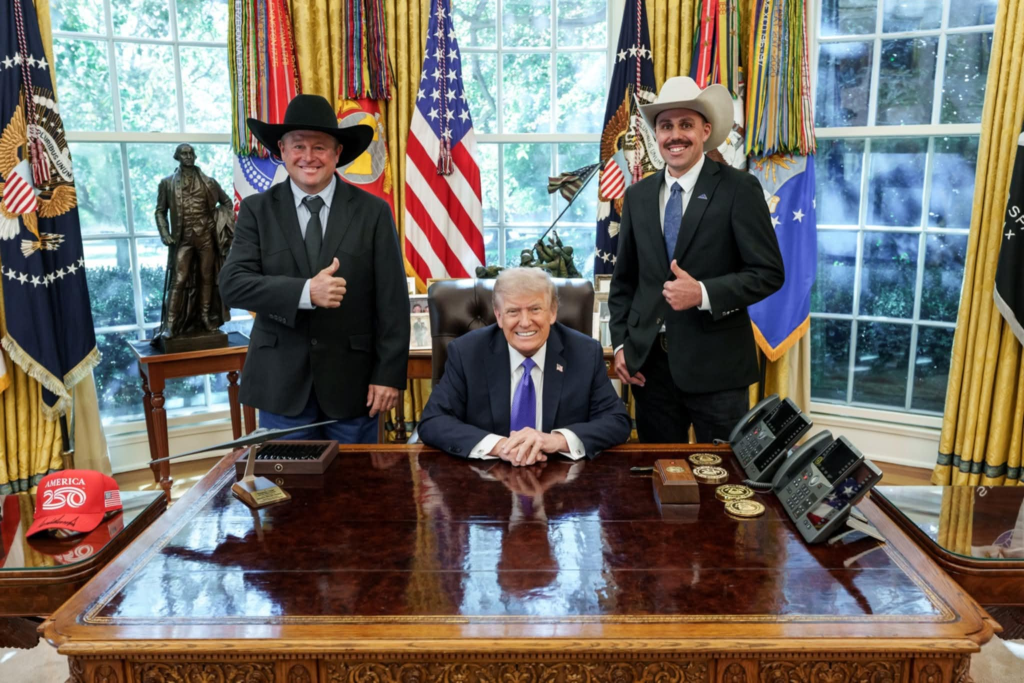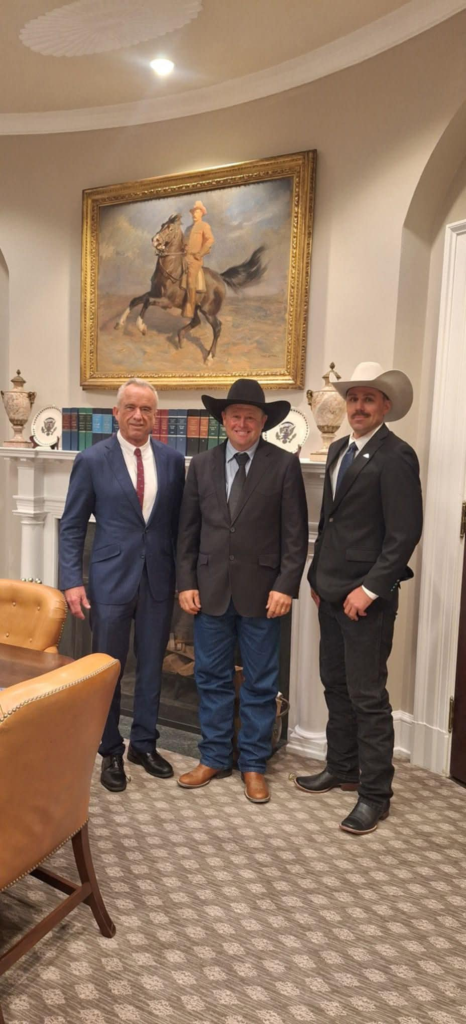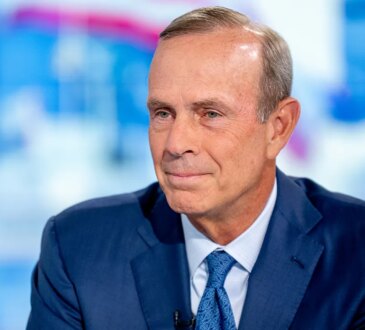

The US Department of Agriculture revealed a plan on Oct. 22, 2025, to “fortify” the American beef industry, strengthen ranches, rebuild capacity and lower costs for consumers.
The plan announcement comes on the heels of several attention-grabbing comments from President Trump including a statement to reporters on Oct. 16 that he had worked his “magic” to lower beef prices, and then a comment on Oct. 19 that he planned to “buy some beef from Argentina.”
Agricultural members of social media platforms discussed little else for days on end – speculating on what kind of deal the president was actually inking, and how it would affect cattle prices. Meanwhile as heated discussions ensued, cattle futures took some hits with live cattle prices remaining strong as a whole, but smaller packages and “misfits” were reported to be slightly devalued when compared to recent months.
Argentina:
A White House official said President Trump’s plan to “lower beef prices” includes raising the tariff rate quota by 4x to allow 80,000 metric tons of beef at a lower rate of duty.
According to USDA, Foot and Mouth disease is not active in Argentina, but it, along with many other countries are considered “free but subject to restrictions,” with the explanation from USDA below:
“The regions listed under paragraph (a)(2) of this section have been declared free of foot-and-mouth disease by APHIS as provided in § 94.1(a) but supplement their national meat supply by the importation of fresh (chilled or frozen) meat of ruminants or swine from regions that APHIS considers to be affected with foot-and-mouth disease as provided in § 94.1(a); or have a common land border with regions considered to be affected with foot-and-mouth disease; or import ruminants or swine from regions considered to be affected with foot-and-mouth disease under conditions less restrictive than would be acceptable for importation into the United States. Thus, the meat may be commingled with the fresh (chilled or frozen) meat of animals from an affected region, resulting in an undue risk of introducing foot-and-mouth disease into the United States,” said the USDA import rule.
Cattle and beef groups say importing beef is not a guarantee of lower prices at the meat counter. Ethan Lane with the National Cattlemen’s Beef Association told The Fence Post that quadrupling of the quota for Argentinian beef will have a “negligible impact” on “the cattle supply chain and the consumer price paid at the grocery store…the fact is we are not talking about a tremendous amount of beef, but we’re talking about additional beef coming from a trading partner that we’ve had long-standing concerns with,” he said they are “not good stewards of cattle health” and referenced trade imbalance with the country.
R-CALF pointed out that the importation of beef has been ongoing for many, many years. “For decades, the government has been inviting imports from countries such as Brazil, Argentina, Namibia, claiming these increased imports would provide consumers more choices and lower consumer beef prices. This did not work and cannot work in a market where these imports are not differentiated with a country of origin labeling and where competitive market forces have been replaced with corporate control by concentrated global beef packers and concentrated beef retailers,” said Bill Bullard, the group’s CEO in a prepared statement.
The USDA cattle and beef plan includes:
1. USDA-DOI Grazing Action plan
Action items: USDA and the Department of Interior signed a Memorandum of Understanding to streamline and expand grazing on federal lands.
USDA will set up regional meetings to identify producer priorities, create a joint (USDA-DOI) customer interface for grazing permit holders, develop new standards of evidence for predation of livestock.
The Risk Management Agency has expanded the beginning farmer definition from five years to 10 years.
2. Consumer transparency
Action items: Beginning January 1, 2026, the USDA Food Safety Inspection Service will enforce compliance on “product of the USA claims” to ensure origin claims are accurate. This is not mandatory Country of Origin Labeling. It is a strengthening of voluntary labeling rules.
Reduce overtime and holiday inspection fees for small processors.
Create a grant application for as many as 50 small beef processors to receive up to $2 million per processor.
3. Build Demand alongside domestic supply
Action items: encouraging schools to source locally grown foods.
New Dietary Guidelines to be released Dec. 31, 2025.
Jack Payne, a rancher and owner of Nevada Livestock Exchange and Hayden Ballard, a rancher and federal lands attorney from Utah, were invited to a private meeting with USDA Secretary Brooke Rollins, U.S. Secretary of Health and Human Services Robert. Kennedy, U.S. Secretary of the Interior Doug Burgum and Kelly Loeffler, the U.S. Secretary of the Small Business Administration.
Payne and Ballard then spoke briefly with President Trump. Payne said he and the president talked momentarily about the effect tariffs and the closure of the Mexican border have had on cattle prices.
Payne said with only about an hour to speak with the Secretaries, he and Ballard were obviously unable to adequately describe all of the challenges facing the U.S. cattle industry.
Because both men had met with Secretary Rollins about six weeks ago, their meeting this past week was a review of those issues they had prioritized earlier, including: restoring suspended and vacant federal grazing allotments, addressing feral horses on federal lands, updating the Endangered Species Act, meat labeling reform, the 30-month rule and checkoff reform.
Ballard said, “The general message from us was we need to restore confidence in our domestic producers and we need to restore confidence in the markets, but we also need to restore confidence for our federal land grazers that they do have a future raising cattle on these allotments,” he added. “To do that we need…well, there’s several things we need, but…to do that, importing beef is not the answer. We already import far more than we should, in my humble opinion.”
He said for the SBA, the priority seems to be to deregulate wherever possible to support small businesses; the USDA’s priority seems to be increasing opportunities for young ranchers to enter the business and provide regulatory relief; from Sec. Kennedy, the focus seems to be improving the dietary guidelines in a way that promotes protein consumption.
As a group, he said the conversation this week reiterated economics, national monument designation, grazing challenges with personnel either unduly influenced by NGOs or who are antigrazing, and ensuring the success of ranchers outside of issuing relief checks.
“My read of the entire USDA at this point is they realize that ranchers don’t want a check – and when I say we don’t want more money, we don’t want more government money, we don’t want a handout, we don’t want more subsidies – just give us a level playing field,” he said.
In previous conversations, Payne and Ballard highlighted the need to re-work the Endangered Species Act. The regulation is used as a tool to force ranchers off federal and private land, and many examples exist of revitalized species that are never delisted, which means land use restrictions are ongoing. They specifically pointed out the need to delist the wolf in light of extreme wolf depredation in areas around the country including California, Colorado and more, and re-introduction of known killing packs in the heart of Colorado.
The ranchers urged support for common sense policies dealing with feral horses on federal lands. Negligence in managing the horses and land has led to unfit conditions on federal lands and in feedlots for the wild equines.

Beef labeling was discussed. Payne said consumers need to understand that they are being misinformed with deceptive labeling and USDA labels that consumers assume are an indication of a USA product.
Payne, who was sorting cattle for a feeder calf sale the following day (Oct. 24, 2025) acknowledged that his consignors are nervous for the sale, and justifiably so. “This is a rancher’s income. The get a check a couple of times a year. A blip or a dip in the market makes a big difference. People who aren’t in the cattle industry don’t understand that,” he said. Payne said he expects the cash price for cattle to remain strong, but he understands why producers and feeders are gun-shy after “black swan” events have crashed rising markets in recent years.
Payne does admit the USDA plan looks subsidy heavy, and he hopes the concentration on policy is the priority.
“I would rather see tax breaks for young producers,” he said. “Instead of giving us money, let us keep our own.”

A.J. Richards, CEO of From the Farm traveled to Washington along with Payne and Ballard. He had also taken part in the earlier meeting with Rollins. He is encouraged to see the rapid response from USDA following their previous discussions. “The plan that was rolled out is a great starting point. The fact that we are only six weeks out from meeting with the Secretary for the first time, and USDA has quickly compiled some solutions is exciting. Really, the big news is the fact that USDA wants to hear from ranchers. As far as I can tell, this is the first time we’ve been heard by USDA in decades. The independents are being heard and actions are being taken, but it won’t get fixed overnight. We’ve got decades of corruption that will take time to uwind and do it in a way that doesn’t collapse our food system,” he said.
Richards knows some producers are watching and thinking USDA isn’t doing enough and isn’t moving at the speed they would like to see. But he said in reality, this week’s actions are a great step and indication that USDA is hearing from the independent producer. “On the producer side, there is so much going on, and because of decades of mistreatment, everyone is on edge. Producers would like to see everything done ‘right now’ but considerations need to be taken so we don’t collapse the food system. We need to focus on the fact that we’re being heard. Secretary Rollins has been in this position less than a year, and she has wrapped her mind around this very complicated industry. In less than a year, she is actually making meaningful change,” he said.
A dozen members of the Common Ground Coalition, a group of beef and cattle spokesman who have obtained producers signatures in support of ag friendly tax policy, more effective risk management tools, improved access to labor, flexibility for livestock haulers and support for young and emerging livestock producers met with U.S. Secretary of Agriculture Brooke Rollins, Sen. Tim Sheehy (R-Mont.), Sen. John Boozman (R-Ark.), Sen. Steve Daines (R-Mont.), Sen. Deb Fischer (R-Neb), Rep. Adam Gray (D-Calif.), Rep. Harriet Hageman (R-Wyo.), Sen. John Hoeven (R-N.D.), Sen. Cindy Hyde-Smith (R-Miss.), Sen. Cynthia Lummis (R-Wyo.), Rep. Barry Moore (R-Ala.), Sen. Pete Ricketts (R-Neb.), Sen. Jim Risch (R-Idaho) and Rep. Dave Taylor (R-Ohio).
According to the group’s news release, their trip happened to coincide with Trump’s comments on Argentinian imports. “The most effective way to make beef more affordable isn’t by artificially manipulating the market with imported product,” said Montana’s Joe Goggins in a news release.
“It’s by helping America’s cattle producers enter and stay in the business of raising cattle. When producers can operate efficiently here at home, everyone benefits – ranchers stay in business, rural communities stay strong and consumers get access to high-quality, affordable U.S. beef,” said Goggins in the news release.
The NCBA sharply criticized the President for his Argentina import suggestion. On Newsmax, Colin Woodall, NCBA CEO said his organization wants the President to know that bringing in extra beef from Argentina won’t reduce prices for consumers. He said producers “don’t get to set the price of beef at the grocery store or restaurants.”
He said the U.S. cattle industry has worked “for decades” to improve its product, and that the quality of beef in the grocery store is better today than in President Trump’s first term.
In order to lower the price of beef for consumers, Woodall said his group urges the administration to address regulatory burden: delist the wolf, address the black vulture “scourge,” and allow more federal lands grazing.
The U.S. Cattlemen’s Association said on Facebook: “We welcome USDA’s new plan…however, reports of a potential deal to import 80,000 metric tons of beef from Argentina – four times the current quota – have overshadowed yesterday’s announcement.
“A deal of this magnitude would undercut family ranchers and threaten the foundation of American cattle production,” said USCA President Justin Tupper. “Flooding the market with imports harms U.S. producers and rural communities. Our policies must strengthen – not risk- American agriculture.”
The Livestock Marketing Association said on Facebook that it is ready to work with the Trump administration on actionable solutions such as improved access to labor, more flexibility for livestock haulers, support for young and emerging livestock producers and protecting the competitive cash market.
R-CALF USA Vice President Eric Gropper told TSLN, the real story of the day is this: “The U.S. Secretary of Agriculture, for the first time in my lifetime, is listening to actual ranchers who own the cattle, who do the day-to-day work. She knows there is a difference between the ranching family who lives off a once-a-year calf check and a paid lobbyist. She wants to hear our ideas and solutions. We couldn’t be more appreciative of that fact,” he said.
Gropper added that the discussion about imported beef has opened the eyes of consumers who previously didn’t realize imported beef existed in this country, and should help gain support for one of their main issues – mandatory country of origin labeling.
On X, R-CALF USA said, “For decades, cattle and beef prices moved together. When beef prices went up, so did cattle prices. But that changed in 2015. Since then, beef prices have climbed while cattle prices lagged behind, creating the widest gap in history. That disconnect is proof of market failure in America’s beef market. Ranchers and consumers are both being exploited while imports rise and the government fails to enforce our antitrust and fair competition laws or restore country of origin labeling.



